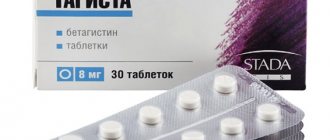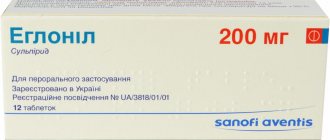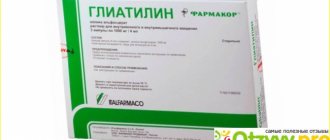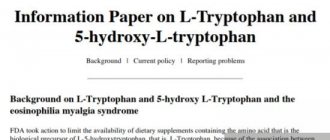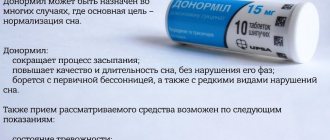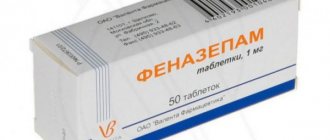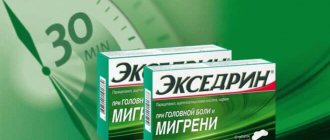What is Grandaxin?
Before we begin to describe the drug, it should be noted that the information provided below is for informational purposes only and in no way constitutes a guide to mandatory treatment.
We cannot determine your diagnosis without conducting examinations, so you must consult with your doctor, establish an accurate diagnosis, and only then take the medicine. Grandaxin is a tranquilizer or anxiolytic, which is a psychotropic drug. The main active ingredient is tofisopam. The drug is available in tablets, one of which contains 50 mg of the active ingredient.
Among the excipients contained in the medicine, magnesium stearate, gelatin, starch, and talc should be noted. All these substances allow you to eliminate psycho-emotional disorders, obsessive fears and worries, as well as cope with negative conditions associated with VSD.
Symptoms
The main symptom of a panic attack is a sudden attack of fear and anxiety. It can be expressed in different ways; the severity of osteochondrosis depends on how severely the nerves and vessels in the cervical region are affected. From mild internal tension, the state can reach severe anxiety.
There are quite a lot of somatic symptoms, some of them may be absent, others may be more pronounced.
- Rapid pulse, strong heartbeat. Feeling as if the heart is about to stop.
- Shortness of breath, suffocation. There is a sharp lack of air.
- Nausea, which can lead to vomiting.
- Unpleasant sensations, pain in the sternum. Sensation of squeezing of the lungs.
- Trembling, tremor of limbs.
- State of derealization - depersonalization. It seems as if the world or a person's sensations are unrealistic, the feeling of being in a dream.
- Confused thoughts, dizziness, even fainting.
- Fear of starting to do anything.
With cervical osteochondrosis, other symptoms are added to this list that do not appear during panic attacks of a different nature. Special symptoms include:
- numbness of the limbs;
- a sharp decrease in visual acuity and hearing;
- severe headache;
- instability, motor dysfunction.
Causes of VSD
VSD can cause malfunction of any organ. The appearance of most diseases is associated with impaired vascular tone.
The most common causes of VSD development are:
- Cardiovascular diseases;
- Endocrine system disorders;
- Allergic diseases;
- Violation of intestinal microflora;
- Pathologies of the liver, gall bladder and bile ducts;
- Gastritis, colitis, ulcers;
- Osteochondrosis;
- Bad habits;
- Sedentary lifestyle.
Classification
Depending on which organ system the disease affects, there are several types of VSD:
- Cardiac VSD – characterized by pain in the left side of the chest, tachycardia;
- Thermoregulatory VSD is a violation of heat exchange, body temperature is constantly changing;
- Respiratory VSD – symptoms similar to asthma appear, constant shortness of breath;
- Genitourinary VSD – the appearance of pain during urination in the absence of organ pathology;
- Dysdynamic VSD – blood flow disturbances, changes and sudden surges in pressure;
- Dyspeptic VSD – disorders of the gastrointestinal tract, diarrhea, vomiting;
- Psychoneurological VSD - characterized by anxiety, insomnia, fatigue, sensitivity to weather changes.
Manifestations of VSD are divided into separate groups, the leading symptom of each of which is dysfunction of a specific body system.
- Cardiac group. It is characterized by pain in the left side of the chest, similar to heart pain. Feeling of lack of air, tachycardia, heart rhythm disturbances, heart failure.
- Respiratory group. A person feels shortness of breath, lack of air, and the inability to fully inhale or exhale. The symptoms are similar to asthmatic manifestations. Appear in cases of nervous overstrain, emotional outburst, excitement, fear.
- The dysdynamic group is characterized by changes in blood pressure, disruption of normal blood flow, resulting in constantly cold extremities.
- Thermoregulatory group. Violations of internal heat exchange manifest themselves in a permanent or temporary increase or decrease in body temperature, which can vary from 35 to 38 degrees.
- Dyspeptic group. Responsible for the functioning of the digestive organs. With VSD, gastrointestinal disorders may occur, accompanied by vomiting, pain, and diarrhea.
- Disorders of the genitourinary system are characterized by a lack of orgasm and painful sensations during urination. In this case, pronounced pathologies and diseases are not detected.
- The psychoneurological group consolidates the most frequent and familiar manifestations of VSD to many people. Among others, decreased performance, fatigue, tearfulness, increased sensitivity to weather conditions and changes in air temperature, insomnia, shuddering during night sleep, restlessness, anxiety, suspiciousness.
Treatment of VSD with the drug Grandaxin
People diagnosed with VSD are characterized by increased anxiety, depression, and are susceptible to panic attacks. To treat this condition, patients are prescribed tranquilizers.
Tranquilizers have a sedative effect in VSD. They support the patient’s normal well-being, helping him cope with mental disorders. However, they have one significant drawback - tranquilizers are addictive in VSD. In medical practice today, a more gentle drug is used - Grandaxin.
The drug Grandaxin for VSD is available in the form of white tablets. One tablet contains 50 mg of active substance.
Reasons why you should choose Grandaxin for treatment
Taking the drug Grandaxin does not cause dependence in patients with VSD and does not exhibit anticonvulsant or muscle relaxant effects. This is its advantage when compared with other benzodiazepanes.
Grandaxin does not affect the ability to concentrate, does not have a hypnotic effect, and can be used without fear during the daytime.
I was just in a terrible state.
Depression and neurasthenia in one bottle.
My health complaints were:
- weakness,
- increased fatigue,
- difficulty concentrating,
- irritability,
- intolerance to loud sounds,
- shallow sleep. I had difficulty falling asleep and also had difficulty waking up unrested. It’s clear that I didn’t want to go to work in this state.
- Plus, I had emotional instability, a terrible mood, which I can’t even call it a mood.
The neurologist prescribed me the tranquilizer Grandaxin, 1 tablet 2 times a day, and the second tablet should be taken before 18:00. The course of admission is 14 days.
What are tranquilizers?
Tranquilizers are substances that have the ability to eliminate or mitigate neurotic manifestations, fear, anxiety, emotional stress, and sleep disorders.
Grandaxin is used for neuroses and neurosis-like conditions, accompanied by tension, vegetative disorders, moderate fear, as well as for conditions characterized by apathy and decreased activity. Also indicated for menopausal neurosis. Prescribed orally 0.05-0.1 g 1-3 times a day.
A week after starting to use Grandaxin, a symptom that greatly tormented me, when all sounds seemed very loud, “went away”. So loud that when you watch TV on the second volume bar, it is so loud for you that it directly puts pressure on your ears.
Grandaxin does not reduce attention and the ability to concentrate; taking it you can drive a car.
I recommend this drug. In my opinion, it is very effective. He dealt with anxiety, irritability and intolerance to loud noises “excellently”. But to be completely honest, pills, no matter how good they are, are only a temporary measure and you should only take them when everything is completely bad, as it was for me, and depression, neuroses and irritability are best treated by eliminating the causes that caused them . I wish everyone good health!
Anxiety states, panic attacks, a feeling of lack of air, unfortunately, are known firsthand to many people belonging to different age categories. This is just a small list of symptoms accompanying vegetative-vascular disorders. Grandaxin for VSD is one of the drugs prescribed by specialists during an exacerbation of the syndrome.
In the uncomplicated form of VSD, when the development of a disease of a particular organ or system of the body is not allowed, the syndrome is easily eliminated by lifestyle changes. A course of prevention of exacerbations of the disease consolidates the favorable results of massage, herbal medicine, acupuncture, exercise therapy and other procedures aimed at strengthening the nervous system.
Many of our readers actively use a well-known method based on natural ingredients, discovered by Elena Malysheva, to TREAT HYPERTENSION. We recommend that you check it out.
When prescribing drug treatment for vegetative-vascular crises accompanied by anxiety and panic attacks, specialists often use the drug Grandaxin.
It gently neutralizes autonomic disorders without having a sedative, muscle relaxant, or anticonvulsant effect. As evidenced by patient reviews, Grandaxin is not addictive and is indicated for use in cases of depression, neuroses, emotional stress, hyperexcitability syndrome, anxiety, and obsessive experiences.
Insomnia and withdrawal symptoms are also on the list of indications for Gandraxin. For menopausal syndrome, Gandraxin is often used as a complex treatment with hormonal drugs. The drug has a number of contraindications and a fairly long list of side effects, including:
- disorders of the gastrointestinal tract, manifested in the form of nausea, loss of appetite, vomiting, diarrhea, flatulence;
- disorders of the central nervous system in the form of insomnia, headache, psycho-emotional agitation, seizures;
- dermatological manifestations in the form of itching, swelling;
- taking Gandraxin in an increased dosage can provoke muscle pain and spasms;
- from the respiratory system, cases of respiratory depression and shortness of breath are observed.
Side effects after taking Gandraxin at the dosage prescribed by the doctor are, as a rule, extremely rare and superficial. Being a mild tranquilizer, Grandaxin is well known to many patients diagnosed with vegetative-vascular dystonia.
Like any drug, Grandaxin has an individual effect, depending on the characteristics of the patient’s body. This is associated with conflicting reviews about the drug. On the one hand, Grandaxin shows maximum effectiveness when prescribed as a course of treatment in combination with antidepressants.
The best treatment for vegetative-vascular dystonia syndrome is the introduction of healthy habits into life. Among them:
- dousing with cold water trains the cardiovascular and nervous system, strengthens the immune system, and has a positive effect on the psycho-emotional background;
- Yoga classes and meditation help to put your thoughts in order, relax, and learn to maintain balance at the psycho-emotional and physical levels;
- daily walks in the fresh air;
- adequate physical activity, especially aerobic exercise, aimed at strengthening the heart and blood vessels;
- teas and decoctions based on herbs that have a mild sedative effect;
- favorite job or hobby;
- favorable emotional background in the workplace and in the family;
- avoiding stressful situations, psycho-emotional and physical stress;
- giving up bad habits such as alcohol and smoking;
- balanced diet.
Experts have ambivalent views on vegetative-vascular dystonia. Many of them are not inclined to consider this syndrome as a disease. The right lifestyle will be the best medicine that will help restore joy and neutralize unpleasant symptoms.
Pharmacological profile
Grandaxin is a benzodiazepine tranquilizer. The main effect is anxiolytic (sedative). Unlike other benzodiazepine tranquilizers, it does not have sedative, hypnotic, muscle relaxant, or anticonvulsant effects.
The medication regulates psycho-vegetatives and relieves various autonomic disorders. Has a moderate stimulating effect. These pharmacological properties determine that the drug belongs to the group of daytime anxiolytics.
Due to the lack of a muscle-relaxing effect, the drug can be taken by patients with myasthenia gravis and myopathy.
The atypicality of the chemical formula of Tofisopam, which is very different from the structure of classical benzodiazepine anxiolytics, gives the drug a number of advantages:
- in a therapeutic dose does not enhance the effect of ethanol;
- does not cause mental or physiological addiction;
- does not cause withdrawal syndrome.
The mechanism of action is associated with a stimulating effect on benzodiazepine receptors in the brain. Their excitation leads to an increase in the sensitivity of GABA receptors to the neurotransmitter. As a result, chlorine channels begin to work more efficiently, hyperpolarization of nerve cell membranes increases, and neuronal activity is weakened.
After oral administration, the active substance is absorbed from the small intestine within a short time and almost completely. The highest concentration in the blood is observed two hours after administration, after which it gradually decreases. Tofisopam does not have the ability to accumulate in the body. Metabolic products are pharmacologically inactive.
The half-life reaches six to eight hours. The active substance is excreted primarily by the kidneys (up to 60-80%) in the form of compounds with a glucose derivative (glucuronic acid) and through the gastrointestinal tract (up to 30%).
Will Grandaxin help get rid of VSD?
The results of clinical studies show that Grandaxin makes life easier for patients, adding optimism. However, Grandaxin is not enough for a complete recovery from the disease. Treatment will be more successful if you use the drug Grandaxin with antidepressants.
By adhering to the following recommendations, you can speed up treatment with Grandaxin and forget about VSD forever:
- Meditation and yoga classes;
- Regular dousing with cold water;
- Rejection of bad habits;
- Regular exercise;
- Balanced diet;
- Walks in the open air;
- Avoiding stressful situations;
- Drinking decoctions and teas with a soothing and relaxing effect;
- Activities according to your own interests and hobbies;
- Maintaining a positive atmosphere at home and at work.
Have you ever tried to bring your blood pressure back to normal? Judging by the fact that you are reading this article, victory was not on your side. And of course you are familiar with the symptoms:
- Do you often experience discomfort in the head area (pain, dizziness)?
- You may suddenly feel weak and tired...
- I constantly feel high blood pressure...
- There is nothing to say about shortness of breath after the slightest physical exertion...
- And you have been taking a bunch of medications for a long time, going on a diet and watching your weight...
But judging by the fact that you are reading these lines, victory is not on your side. That is why we recommend that you familiarize yourself with a new technique that is suitable for treating hypertension and cleaning blood vessels. Read the interview.
Indications for use
Reviews of Grandaxin for VSD are usually positive, since the drug really helps to cope with many symptoms of the disease. Indications for its use are as follows:
- Vegetative-vascular dystonia and conditions accompanying this disease.
- Neuroses, including severe anxiety states, obsessive fears, anxiety, autonomic disorders.
- Depression and its types.
- Physical stress and excessive mental fatigue.
- Withdrawal syndrome.
In addition, the drug is intended to eliminate:
- obsessive experiences;
- mental disorders;
- myasthenia gravis;
- pain and anxiety in the premenstrual period;
- alcohol addiction.
As you can see, Grandaxin has a wide spectrum of action and can cope with even the most intractable diseases and conditions.
All tranquilizers require strict adherence to the rules described in the instructions for use of the drug; Grandaxin is no exception.
The dosage of the drug is prescribed individually after examination by a doctor. This takes into account the patient’s age, degree of disease, symptoms, and sensitivity to the drug. As a rule, adults are prescribed 1-2 tablets 2-3 times a day.
Carefully read the instructions for use before using the product to treat vegetative-vascular dystonia or any other disease.
The dosage of the drug is prescribed individually after examination by a doctor. This takes into account the patient’s age, degree of disease, symptoms, and sensitivity to the drug. As a rule, adults are prescribed 1-2 tablets 2-3 times a day.
Anxiety, panic attacks, uncontrollable fear, a feeling of lack of air and suffocation - hundreds of people face all these conditions every day.
Cases of vegetative-vascular dystonia (VSD) are observed in various age groups. The disorder is accompanied not only by the symptoms listed above, but also by many other unpleasant conditions.
Grandaxin for VSD is one of the drugs that neurologists often prescribe during exacerbations, as well as to maintain the nervous system.
- All information on the site is for informational purposes only and is NOT a guide to action!
- Only a DOCTOR can give you an ACCURATE DIAGNOSIS!
- We kindly ask you NOT to self-medicate, but to make an appointment with a specialist!
- Health to you and your loved ones!
The main indication for use is conditions that are accompanied by emotional stress and moderate fear. The drug is taken for disorders accompanied by vegetative disorders and apathy.
In addition, the drug is taken:
- in conditions accompanied by reduced activity;
- obsessive experiences;
- premenstrual syndrome;
- during menopause;
- for post-traumatic stress disorders;
- impaired psycho-emotional adaptation;
- myasthenia gravis;
- myopathies;
- chronic alcoholism.
The entry of any drug into the body does not mean that the mental state will immediately improve, consciousness will become clearer, and thoughts will normalize. In a healthy person, the function of the cerebral cortex is inextricably linked with the functional state of the subcortical regions.
In people suffering from VSD, the situation is different: with the development of the disorder, the subcortical sections do not cope with their function - the self-preservation of the body under various conditions. Because of this, indications for taking Grandaxin are determined by the state of consciousness where thoughts are formed.
How much Grandaxin to drink for VSD is a question that falls under the competence of the doctor. The dosage is prescribed individually depending on the patient's condition.
Usually one or two tablets are prescribed up to three times a day, and to maintain the condition you can take one tablet at a time
In the modern world, under the influence of an abundance of stress, many people can no longer independently control their psychological state, and therefore are forced to resort to the use of sedatives. Read information about Grandaxin, a drug from this group of drugs. Information about its action and the price of tablets may be useful to you.
This medicine belongs to the group of tranquilizers - drugs that tend to relieve anxiety and fear. The effect of using these tablets received many positive reviews from patients. Even taking this into account, you still cannot decide to take a course of Grandaxin on your own - the instructions for using the drug state that it must be dispensed with a prescription.
This condition is logical: although today in the world around us there are many factors that can unbalance the nervous system, uncontrolled use of drugs with psychotropic effects carries many serious and sometimes unforeseen risks. For this reason, only a doctor should determine how to take Grandaxin for each specific patient.
Clinical trials
Grandaxin is a unique CNS-active drug that has undergone many clinical trials. The drug does not have a sedative or muscle relaxant effect, and does not impair intellectual and psychomotor activity, unlike other benzodiazepines.
The drug has a mild cognitive-stimulating effect, a powerful drug that is prescribed to reduce autonomic disorders that accompany psychotic and nervous conditions.
Tofisopam does not have an anticonvulsant effect and even in a subtoxic dose does not cause sedation. Subtoxic dosages are potentiated only by barbiturates and ethanol.
The use of a dosage of the active substance in excess of 200 mg/kg in animals caused an effect similar to antipsychotics. When a dose of 10 mg/kg was administered, a normalizing effect on the temporary organization of animal behavior and the prevention of stress dysrhythmia was revealed.
The effectiveness of the drug in neurological practice was revealed during a multicenter study in which clinics from 11 Russian cities took part. The results of the study were based on observation data of 220 patients aged 18-55 years with psychovegetative syndrome (PVS).
The main group of patients (140 people) took Grandaxin tablets in addition to traditional treatment. The control group (80 people) was prescribed standard treatment with vascular and metabolic drugs without the participation of drugs. By the second week of treatment, personal and reactive anxiety decreased in both groups, but significant changes were noted specifically in the first group (they took Tofisopam).
Similar dynamics were observed in the fourth week of therapy. If at the beginning of the course both groups did not differ in the level of anxiety, then by the end of the second and especially the fourth week the degree of anxiety decreased much more than in the control group (they did not take Tofisopam).
The degree of vegetative-vascular dystonia was assessed through a questionnaire, during which subjective and objective disorders in patients were identified. The average indicators of the severity of autonomic disorders in both groups at the beginning of treatment did not differ.
By the end of the second and especially the fourth week, the scores in the first group were much lower than in the control group.
Thus, the use of Grandaxin has significantly improved the condition of patients, normalized autonomic imbalance and improved the quality of life.
To study the sedative and hypnotic properties of the drug, a study was conducted in which 60 conscripts aged 19-25 years with a minimum driving experience of one year participated. The first group of participants took Tofisopam, the second took pills with a placebo effect of a similar appearance, then the groups changed.
During the entire study period, not a single minor accident or incident occurred. Twelve individuals noted that while driving a truck they did not feel any stress and were able to cope with difficulties much more easily. 5 people indicated a similar effect when taking placebo, but these positive effects were also attributed to the period of taking Grandaxin.
Contraindications and side effects
Indications for use of Grandaxin are as follows:
- depression;
- neuroses;
- stress;
- excessive fatigue;
- myasthenia gravis, myopathy;
- VSD;
- menopausal syndrome;
- withdrawal syndrome.
It is better to avoid using Grandaxin in the following cases:
- First trimester of pregnancy.
- Breastfeeding a baby.
- Galactose intolerance.
- Respiratory failure, when normal blood composition is not maintained.
- Apnea syndrome (stopping breathing during sleep).
- High level of aggression.
- Severe depression.
- Sensitivity to one of the components of the drug.
- Chronic psychosis.
- Obsessive states.
- Phobias.
Grandaxin is prescribed with caution in cases of brain damage, the development of acute respiratory failure, epilepsy, and angle-closure glaucoma.
It is important to know the possible side effects of the drug, as well as cases in which the use of the drug is strictly contraindicated. In the following situations, it is advisable to refrain from using the product:
- The first months of pregnancy.
- Respiratory failure.
- Anxiety states that are accompanied by pronounced mental arousal.
- Breastfeeding period.
- The presence of hypersensitivity to the main active ingredient of the drug.
All these contraindications, as well as overdose, can lead to the following side effects:
- Increased irritability.
- Insomnia.
- A sharp decrease in appetite.
- Skin itching.
- Excessive muscle tension.
The main contraindication is hypersensitivity to the components of the drug.
special instructions
It is necessary to take into account that in patients with mental disorders, the elderly, and those with impaired liver and kidney function, side effects occur more often than others.
In case of renal failure, the daily dosage is reduced by approximately half.
For chronic psychoses, phobias, and obsessions, it is not recommended to take medicine. In such conditions, suicidal thoughts and aggressiveness may occur. For this reason, the drug should not be prescribed as independent therapy for depression and anxiety-depressive conditions.
Care should be taken when treating depersonalized individuals and patients with organic brain damage.
In epileptics, the medication increases the seizure threshold.
Since the drug contains lactose, this should be taken into account in patients with intolerance to this component.
Recommendations for driving vehicles and machinery: the tranquilizer does not have a significant effect on the ability to concentrate.
The medication does not enhance the effect of alcohol when taken in therapeutic doses; moreover, Grandaxin reduces the inhibitory effect of ethanol on the central nervous system.
Basilar migraine is a headache with dangerous consequences.
Basilar migraine (Bickerstaff, syncope) is a chronic neurological disease. This type of pathology is quite rare and represents a separate form - migraine of the basilar artery.
Women aged 20 to 50 years, especially those with a thin build, are at risk.
The attack is preceded by an acute aura, which is characterized by dizziness, ringing in the ears, hearing loss, and visual disturbances.
At the peak of pain, a person may lose consciousness or fall into a coma. Painful symptoms are not associated with the level of blood or internal pressure, eye diseases, or head injuries.
Attacks usually begin unpredictably, and they can occur as rarely as several times a year, or as often as every week.
To date, experts have not been able to come to a consensus on why basilar-type migraines develop.
As already mentioned, more than 90% of patients are women of reproductive age. A very interesting fact is that with age, attacks become less vivid and occur at greater intervals.
People prone to migraines are characterized by a high level of susceptibility to various even minor irritants - unpleasant odors, loud sounds, bright harsh light.
Clinical picture
The attack will certainly be preceded by an aura, which manifests itself as follows:
- a person feels dizzy and has an irresistible desire to sleep;
- severe weakness appears throughout the body;
- in some cases, speech disorders may occur.
During an attack, nausea and vomiting may occur, and sometimes the person may lose consciousness. Severe cases are characterized by partial paralysis of half the body or paralysis of both arms and legs. Adverse symptoms may persist after an attack for a long time - from several hours or more.
The headache is localized on the left or right, radiating to the eyes, neck, lower jaw, and chin. The pain is very sharp and throbbing, often occurring in the back of the head, because this is where the basilar artery is located, which is responsible for blood circulation in the occipital lobe of the brain, brainstem and cerebellum.
The most important condition for the patient’s well-being is the selection of the correct therapy and prevention of exacerbations.
Many doctors recommend that their patients keep special notebooks where they need to note the rate of change in their physiological state, as well as write down those reasons that, even indirectly, could influence the occurrence of an attack. A person must independently learn to avoid contact with provoking factors that entail such changes.
The treatment of syncopal migraine itself primarily consists of eliminating acute symptoms at the time of a headache attack. An effective drug is selected by the attending physician, taking into account all the individual characteristics of the body.
The benefits and harms of tranquilizers for VSD
But first you need to understand the beneficial and harmful properties of tranquilizers in the treatment of vegetative-vascular dystonia. First of all, you should be aware of the fact that all these drugs are dispensed exclusively according to special prescriptions from doctors. This means that under no circumstances should you self-medicate.
These medications are intended to maintain the general well-being of a patient with VSD and maintain his health in a normal state, relieving him of anxiety disorders and other symptoms of the disease. In other words, the patient’s quality of life will largely depend on treatment with tranquilizers.
The benefits of their use are the following:
- Helps cope with neurosis, depression and other mental disorders.
- Easily eliminate signs of the disease.
- Allows you to undergo a full course of treatment for VSD.
At the same time, there are some disadvantages of such drugs:
- They can cause drug dependence when there is a craving for the drug and the inability to control the dosage of taking it.
- Treatment cannot last long, as there are certain contraindications.
- Tranquilizers are not suitable for all people.
In any case, you need to seek help from an experienced doctor, who will explain in detail all the pros and cons of using such drugs, and also make a conclusion about whether you can use them to treat vegetative-vascular dystonia.
Point of view
Opinion of specialists and reviews of patients who took Grandaxin as a course or spot-on.
Professional opinion
Patient reviews
The main advice from people taking medication is that you should not take a tranquilizer at night, it is better to do it during the day.
This recommendation is fully consistent with the official instructions and description of the product, since Grandaxin is a daytime anxiolytic.
The advantages include the following:
- does not cause drowsiness;
- does not enhance the effects of alcohol;
- does not cause addiction;
- does not reduce concentration.
Of the minuses, it should be noted that the drug is not able to cope with severe depression, and also that side effects may occur if liver and kidney function are impaired.
